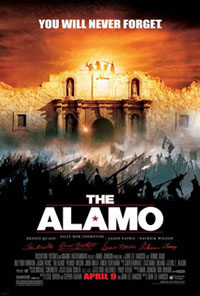 THE ALAMO
THE ALAMO(PG-13)
**1/2 (out of 5)
April 9, 2004
STARRING
Dennis Quaid as SAM HOUSTON
Billy Bob Thornton as DAVY CROCKETT
Jason Patric as JAMES BOWIE
Patrick Wilson as WILLIAM TRAVIS
Emilio Echeverria as ANTONIO LOPEZ DE SANTA ANNA
Jordi Molla as JUAN SEQUIN
Studio: Touchstone
Directed by: John Lee Hancock
BY KEVIN CARR
Any historical film will always be scrutinized for its accuracy. And considering that Touchstone’s other film in the theaters right now – “Hidalgo” – is far from being historically accurate, this is a very valid question in regards to “The Alamo.”
Well, in terms of historical accuracy, “The Alamo” is probably as close as you’re gonna come by Hollywood standards. Now, I’m no historian, and I’m certainly no Texas historian by a long shot. However, I can read a blurb in an encyclopedia as well as the next guy. (And, after all, are we ever really asking anything more out of Hollywood than an encyclopedic accuracy?)
Much of what you’ll see on the screen with “The Alamo” happened. The sequence of events and the people involved all seem to be pretty solid. The famous names involved in the history of the Texas revolution – including most notably Davy Crockett, Jim Bowie, William Travis and Sam Houston – seem to be right out of the history books. Sure, there’s liberties taken as there are with any film, but nothing that stems too far from the truth.
However, the problem with “The Alamo” does not lie within the bounds of historical accuracy. It lies within the bounds of story construction and execution. Maybe there’s something to be said for dramatic license. After all, the character of Viggo Mortensen’s radically inaccurate portrayal of Frank Hopkins in “Hidalgo” can inspire an audience. The characters in “The Alamo,” on the other hand, seem to have walked right out of a documentary rather than an action film.
The only famous name that was really done justice was Crockett. He’s the only character that really had some meat to him. Billy Bob Thornton’s portrayal showed a real man carrying the burden of a legend. He was one of the few that I actually cared about.
Jason Patric’s Bowie spent too much time whipping out his famous knife, flashing back to his wife, then waiting around through the film to die. Dennis Quaid’s Sam Houston spent too much time brooding and delivering lines as if they come from a script written by the Texas Board of Education. Patrick Wilson as Travis was the only other one who had some substance to work with, but much of him was wasted.
But I don’t blame the actors, really. Generally, it’s hard to get into any character when you know they’re all going to die, anyway. This isn’t the Titanic, which had several hundred survivors. This is the Alamo, famous for its crushing defeat. At least writer/director John Lee Hancock didn’t resort to a “Pearl Harbor” storyline with lovers set against the historical backdrop.
Hancock couldn’t resist making this film politically correct. He painted Santa Anna the only villain, leaving the entire Mexican army to be portrayed as reluctant participants in the war. Even his high-level advisors were shown as being forced to carry out his atrocities.
While Santa Anna was no saint (pardon the pun, please), he was still a powerful leader that commanded the Mexican army against the Texains and Tejanos in the Alamo. In the film, he is shown in a ridiculous over-the-top fashion. He’s a caricature rather than a real villain. I saw a comment on the Internet in which someone compared him to a James Bond villain – and this is absolutely true.
The few times you see past the uniform to a Mexican soldier, he is portrayed as a trembling, terrified child. I’m sure there were plenty of young men fighting in the Mexican army, but there were plenty of seasoned soldiers who had no qualms about slaughtering every last Texan holed up in the Alamo. Unfortunately, if the freedom fighters who lost their lives in 1836 were the heroes history sees them as, you have to view the Mexican soldiers as the enemy.
Something was missing from the film. It lacked punch. Even the final push on the Alamo, which only lasted 90 minutes in real life, zipped by too quickly. There was no real sense of hopelessness or desperation. Maybe this was because the Mexicans breached the walls too quickly. Maybe this was because the movie was already too long at that point. Maybe this was because it was trying to honor the heroes while hammering home a tired “war is hell” message.
Ultimately, “The Alamo” is a nice historical reference. It’s shot beautifully, and the essentials that make a film work are all there. But it’s like eating soup without seasoning. There’s no real punch. No kick. I’m sure it’ll be shown in Texas classrooms for years to come, but the story – which is the essence of a movie – just didn’t grab me.
